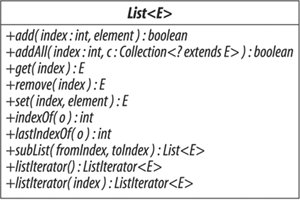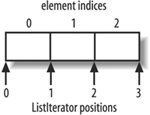Chapter 15. Lists
| Lists are probably the most widely used Java collections in practice. A list is a collection whichunlike a setcan contain duplicates, and whichunlike a queuegives the user full visibility and control over the ordering of its elements. The corresponding Collections Framework interface is List (see Figure 15.1). Figure 15-1. List In addition to the operations inherited from Collection, the List interface includes operations for the following: Positional Access Methods that access elements based on their numerical position in the list: void add(int index, E e) // add element e at given index boolean addAll(int index, Collection<? extends E> c) // add contents of c at given index E get(int index) // return element with given index E remove(int index) // remove element with given index E set(int index, E e) // replace element with given index by e Search Methods that search for a specified object in the list and return its numerical position. These methods return -1 if the object is not present: int indexOf(Object o) // return index of first occurrence of o int lastIndexOf(Object o) // return index of last occurrence of o Range-View A method that gets a view of a range of the list: List<E> subList(int fromIndex, int toIndex) // return a view of a portion of the list The method subList works in a similar way to the subSet operations on SortedSet (see Section 13.2), but uses the position of elements in the list rather than their values: the returned list contains the list elements starting at fromIndex, up to but not including toIndex. The returned list has no separate existenceit is just a view of part of the list from which it was obtained, so changes in it are reflected in the original list. There is an important difference from subSet, though; changes you make to the sublist write through to the backing list, but the reverse is not always true. If elements have been inserted into or removed from the backing list by directly calling one of its "structure changing" methods (Section 12.1), any subsequent attempts to use the sublist will result in a ConcurrentModificationException. List Iteration Methods that return a ListIterator, which is an Iterator with extended semantics to take advantage of the list's sequential nature: ListIterator<E> listIterator() // return a ListIterator for this list, // initially positioned at index 0 ListIterator<E> listIterator(int indx) // return a ListIterator for this list, // initially positioned at index indx The methods added by ListIterator support traversing a list in reverse order, changing list elements or adding new ones, and getting the current position of the iterator. The current position of a ListIterator always lies between two elements, so in a list of length n, there are n+1 valid list iterator positions, from 0 (before the first element) to n (after the last one). The second overload of listIterator uses the supplied value to set the initial position of the listIterator to one of these positions (calling listIterator with no arguments is the same as supplying an argument of 0.) To the Iterator methods hasNext, next, and remove, ListIterator adds the following methods: public interface ListIterator<E> extends Iterator<E> { void add(E e); // insert the specified element into the list boolean hasPrevious(); // return true if this list iterator has further // elements in the reverse direction int nextIndex(); // return the index of the element that would be // returned by a subsequent call to next E previous(); // return the previous element in the list int previousIndex(); // return the index of the element that would be // returned by a subsequent call to previous void set(E e); // replace the last element returned by next or // previous with the specified element } Figure 15.2 shows a list of three elements. Consider an iterator at position 2, either moved there from elsewhere or created there by a call to listIterator(2). The effect of most of the operations of this iterator is intuitive; add inserts an element at the current iterator position (between the elements at index 1 and 2), hasPrevious and hasNext return true, previous and next return the elements at indices 1 and 2 respectively, and previousIndex and nextIndex return those indices themselves. At the extreme positions of the list, 0 and 3 in the figure, previousIndex and nextIndex would return -1 and 3 (the size of the list) respectively, and previous or next, respectively, would throw NoSuchElementException. Figure 15-2. ListIterator positions The operations set and remove work differently. Their effect depends not on the current position of the iterator, but on its "current element", the one last traversed over using next or previous: set replaces the current element, and remove removes it. If there is no current element, either because the iterator has just been created, or because the current element has been removed, these methods will throw IllegalStateException. |
EAN: 2147483647
Pages: 136